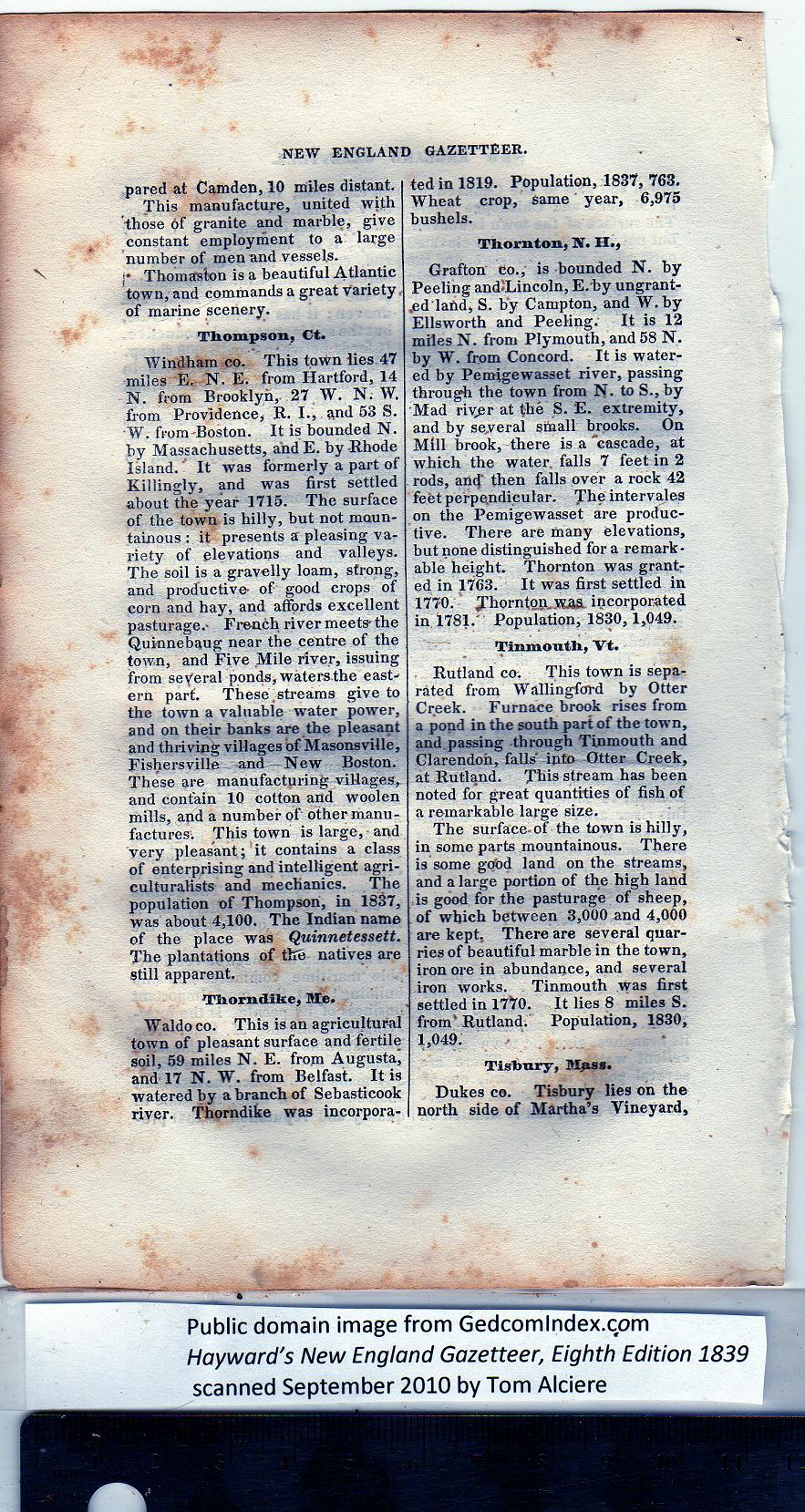|
pared at Camden, 10 miles distant.
This manufacture, united with
those of granite and marble, give
constant employment to a large
number of men and vessels.
;• Thomaston is a beautiful Atlantic
town, and commands a great variety,
of marine scenery.
Thompson, Ct.
Windham co. This town lies 47
miles E. N. E. from Hartford, 14
N. from Brooklyn, 27 W. N. W.
from Providence, R. I., and 53 S.
W. from Boston. It is bounded N.
by Massachusetts, andE. by Rhode
Island. ’ It was formerly a part of
Killingly, and was first settled
about the year 1715. The surface
of the town is hilly, but not moun-
tainous : it presents a pleasing va-
riety of elevations and valleys.
The soil is a gravelly loam, strong,
and productive- of good crops of
corn and hay, and affords excellent
pasturage.- French river meets' the
Quinnebaug near the centre of the
town, and Five Mile river, issuing
from several ponds, waters the east-
ern part. These.streams give to
the town a valuable water power,
aDd on their banks are the pleasant
and thriving villages of Masonsville,
Fishersville and - New Boston.
These are manufacturing villages,
and contain 10 cotton and woolen
mills, and a number of other manu-
factures. This town is large, and
very pleasant; it contains a class
of enterprising and intelligent agri-
culturalists and mechanics. The
population of Thompson, in 1837,
was about 4,100. The Indian name
of the place was Quinnetessett.
The plantations of tbe natives are
still apparent.
Thorndike, Me.
Waldo co. This is an agricultural
town of pleasant surface and fertile
soil, 59 miles N. E. from Augusta,
and 17 N. W. from Belfast. It is
watered by a branch of Sebasticook
river. Thorndike was incorpora-
ted in 1819. Population, 1837, 763.
Wheat crop, same year, 6,975
bushels. |
Thornton, N. H.,
Grafton co., is bounded N. by
Peeling and*Lincoln, E.by ungrant-
jed land, S. by Campton, and W. by
Ellsworth and Peeling. It is 12
miles N. from Plymouth, and 58 N.
by W. from Concord. It is water-
ed by Pemigewasset river, passing
through the town from N. to S., by
Mad riyer at the S. E. extremity,
and by several small brooks. On
Mill brook, there is a "cascade, at
which the water, falls 7 feet in 2
rods, and then falls over a rock 42
feet perpendicular. The intervales
on the Pemigewasset are produc-
tive. There are many elevations,
but none distinguished for a remark*
able height. Thornton was grant-
ed in 1763. It was first settled in
1770. ^hornton was. incorporated
in 1781.' Population, 1830,1,049.
Tinmouth, Vt.
Rutland co. This town is sepa-
rated from Wallingford by Otter
Creek. Furnace brook rises from
a pond in the south part of tbe town,
and passing through Tinmouth and
Clarendon, falls' into Otter Creek,
at Rutland. This stream has been
noted for great quantities of fish of
a remarkable large size.
The surface, of the town is hilly,
in some parts mountainous. There
is some good land on the streams,
and a large portion of the high land
is good for the pasturage of sheep,
of which between 3,000 and 4,000
are kept, There are several quar-
ries of beautiful marble in the town,
iron ore in abundance, and several
iron works. Tinmouth was first
settled in 1770. It lies 8 miles S.
from* Rutland. Population, 1830,
1,049.
Tisbury,
Dukes co. Tisbury lies on the
north side of Martha’s Vineyard, |
